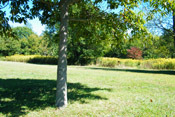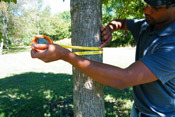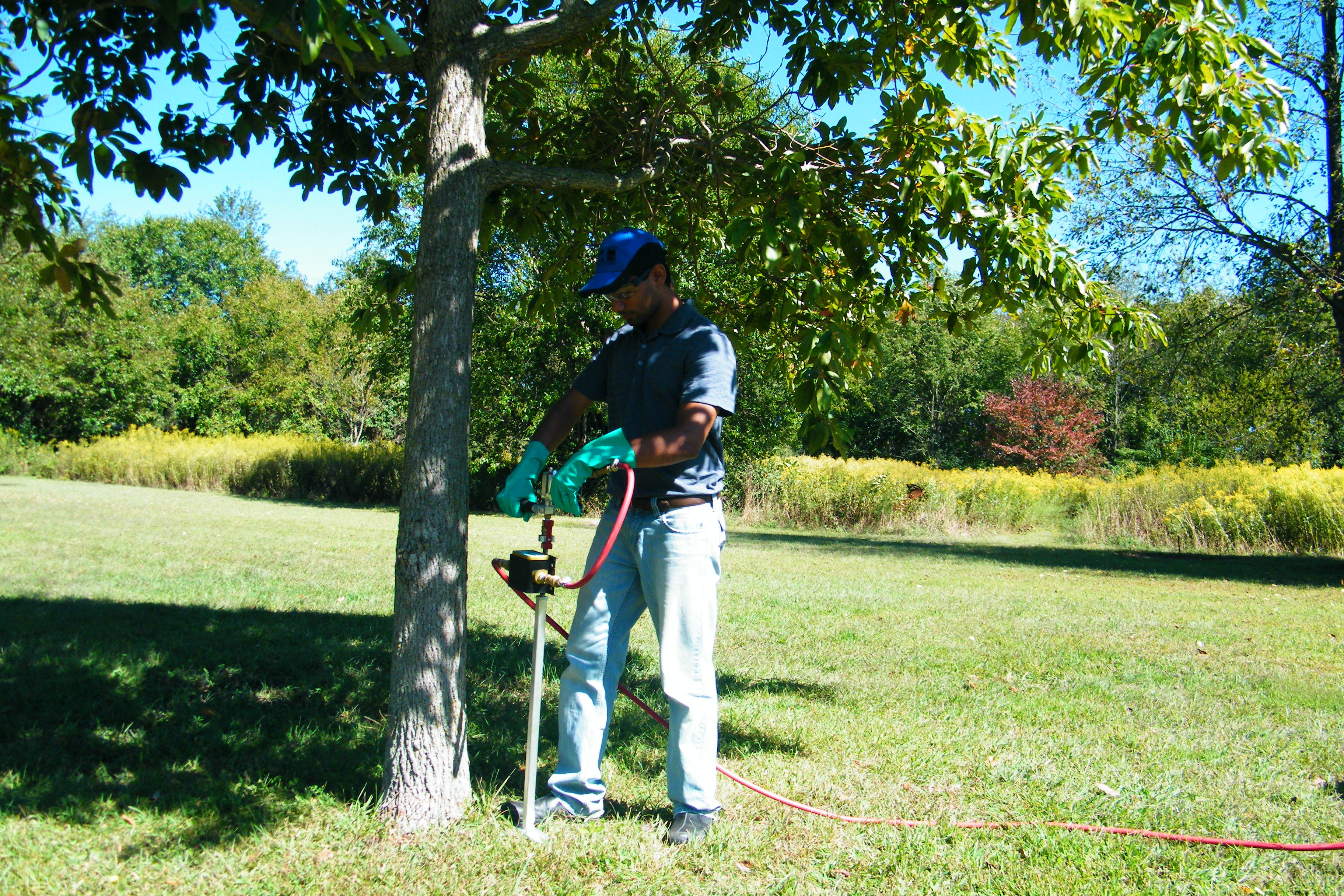 Tree Growth Regulator Applications
Tree Growth Regulator Applications
STEPS FOR TREE GROWTH REGULATOR APPLICATIONS
Step 1 - Identify the species and determine the crown size

Examine the area around the base of the tree for any obstructions, acknowledge the health of the tree, and decide if the crown size is normal (lg) or altered (sm). Make notes on any issues of concern. Do not make an application on a tree with 40% or more of its crown dying or missing.
Step 2 - Measure the Diameter at Breast Height and calculate the volume

The dbh is measured at approx. 4.5 ft above ground. The species and dbh are used to calculate the volume needed for the TGR application. Our slide chart has 12 categories of arborist rates given in volume increments of milliliters, Liters, ounces, and gallons.
See mixing instructions for Ready-To-Use solution below
Step 3 - Choose type of Application
Basal or Soil Drench
Pros & Cons: Applications is low cost and good for small jobs. The time of application for one tree is about 10-35 minutes depending on the soils compaction, moisture content, & texture.
Minimum Equipment Needed: trowel or Cats Claw, tray, and graduated cylinder or measuring cup.
Basal (Soil) Drench: The application is made by digging a trench (3” deep x 2-3” wide) around the base of the tree. Carefully pour the calculated volume of RTU into the trench. IMPORTANT: the liquid should be evenly distributed for effective results. Once the TGR is absorbed into the soil, push the dirt back into the trench firmly.


Special Notes: Check for obstructions around the base of the tree such as rocks, buildings, and cement. When performing a basal drench on clay soils, avoid applying sooner than 12 hours before a forecasted heavy rain. Avoid off-site movement of product on slopes of 10% or greater. Do not allow the product to settle more to one side of the tree than the other (create mini-trenches).
Soil Injection
Pros & Cons: Applications are very fast & easy but require more specialized equipment. The application of one tree is approximately 4-7 minutes.
Minimum Equipment Needed: soil probe, flowmeter, and tank source with pressure.
Soil Injection: Using a soil probe (depth 6”), apply the RTU in a circular pattern around the base of the tree. IMPORTANT: injection sites (holes) should be evenly distributed for effective results. Each injection site (hole) should have about 200-250 mLs. The pressure should be approximately 80-120 psi but if the soil is very compacted or hard clay, reduce the pressure & make more holes


Special Notes: Injection sites should be evenly distributed around the base, within 1-4 feet from the tree, and spaced 8-12 inches from each other. Each hole should contain approximately 200-250 mLs. The pressure that is most suitable for soil injections is 80-120 psi. Additionally the injection should be at a depth of 6 inches, deeper than grass roots.
Mixing Instructions for ShortStop TGR
Examples:
- 1 Liter conc. to 11 Liters water
- 100 mLs conc. to 1100 mLs water
- Half gallon conc. to 5.5 gallons water
- 32 ounces conc. to 352 ounces water
If the ratio is kept consistent, any volume can be made. Both ShortStop TGR concentrate and its Ready-to-Use (RTU) mixture have a long shelf-life, just be sure to mix the RTU up well before using.
There are two basic ways to make and use RTU mixture:
Big batch to use on many trees or woody shrubs or individual dosage for one tree or woody shrub
We believe it is EASIER to make bigger batches (1-6 gallons) before you leave the workplace and use as needed. There is no need for a water source, less likelihood of spill over, and it makes the application go faster.
Our TGR rate information gives the measurements for both types of volume calculations and it’s in multiple units: milliliters, Liters, ounces, and gallons.
LENGTH OF CONTROL FOR SHORTSTOP TREE GROWTH REGULATOR
The length of time an area has for it’s growing season directly effects the length of control on the tree. Longer growing season means the tree will utilize more of the TGR, resulting in a shorter amount of control time and vice versa. Of course there is always local variation for growth control, therefore this map should be viewed as a guideline only.

Ask the Experts
Visit the Ask the Experts Page to see more info on:
- Backpack versus Tank Applications
- Problem Solving
- When NOT to apply TGRs
- Visit the Ask the Experts Page
Find more information, select any of the items below
- Equipment for Basal/Soil Drench
- Soil Injection Equipment
- Application Article (“To Apply or Not to Apply, that is the Question…” PDF)
- TGR Rate Slide Chart
- Sales Opportunities and Pricing for TGR Applications
- TGR Arborist Application Methods & Est
- TGR Arborist Uses
- Interested in Ordering or want someone to contact you?
- How to Price your TGR Jobs
